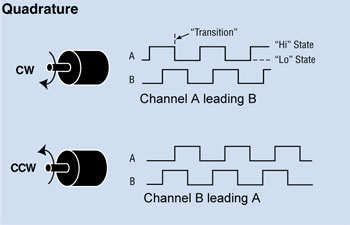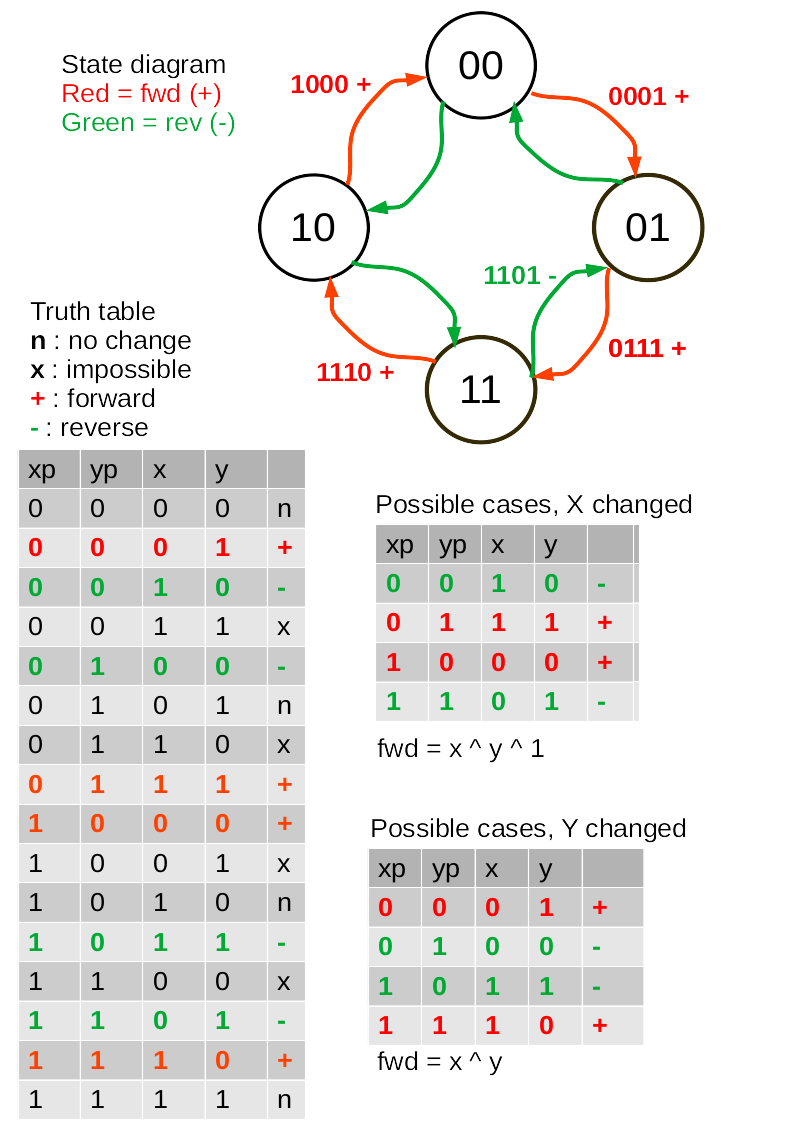9.9 KiB
Incremental encoders
There are three technologies that I am aware of:
- Optical.
- Magnetic.
- Mechanical (using switch contacts).
All produce quadrature signals looking like this:

consequently the same code may be used regardless of encoder type.
They have two primary applications:
- Shaft position and speed measurements on machines.
- Control knobs for user input. For user input a mechanical device, being inexpensive, usually suffices. See this Adafruit product.
In applications such as NC machines longevity and reliability are paramount: this normally rules out mechanical devices. Rotational speed is also likely to be too high. In machine tools it is vital to maintain perfect accuracy over very long periods. This may impact the electronic design of the interface between the encoder and the host. High precision comes at no cost in code, but there may be issues in devices with high interrupt latency such as ESP32, especially with SPIRAM.
The ideal host, especially for precison applications, is a Pyboard. This is because Pyboard timers can decode in hardware, as shown in this script from Dave Hylands. Hardware decoding eliminates all concerns over interrupt latency or input pulse rates.
Basic encoder script
This comes from encoder_portable.py in this repo. It uses the simplest and
fastest algorithm I know. It should run on any MicrPython platform, but please
read the following notes as there are potential issues.
from machine import Pin
class Encoder:
def __init__(self, pin_x, pin_y, scale=1):
self.scale = scale
self.forward = True
self.pin_x = pin_x
self.pin_y = pin_y
self._pos = 0
try:
self.x_interrupt = pin_x.irq(trigger=Pin.IRQ_RISING | Pin.IRQ_FALLING, handler=self.x_callback, hard=True)
self.y_interrupt = pin_y.irq(trigger=Pin.IRQ_RISING | Pin.IRQ_FALLING, handler=self.y_callback, hard=True)
except TypeError:
self.x_interrupt = pin_x.irq(trigger=Pin.IRQ_RISING | Pin.IRQ_FALLING, handler=self.x_callback)
self.y_interrupt = pin_y.irq(trigger=Pin.IRQ_RISING | Pin.IRQ_FALLING, handler=self.y_callback)
def x_callback(self, pin):
self.forward = pin() ^ self.pin_y()
self._pos += 1 if self.forward else -1
def y_callback(self, pin):
self.forward = self.pin_x() ^ pin() ^ 1
self._pos += 1 if self.forward else -1
def position(self, value=None):
if value is not None:
self._pos = round(value / self.scale)
return self._pos * self.scale
If the direction is incorrect, transpose the X and Y pins in the constructor call.
Problem 1: Interrupt latency
By default, pin interrupts defined using the machine module are soft. This
introduces latency if a line changes state when a garbage collection is in
progress. The above script attempts to use hard IRQ's, but not all platforms
support them (notably ESP8266 and ESP32).
Hard IRQ's present their own issues documented here but the above script conforms with these rules.
Problem 2: Jitter
The picture above is idealised. In practice it is possible to receive a succession of edges on one input line, with no transitions on the other. On mechanical encoders this may be caused by contact bounce. On any type it can result from vibration, where the encoder happens to stop at an angle exactly matching an edge. An arbitrarily long sequence of pulses on one line is the result; the frequency may be arbitrarily high. A correct algorithm must be able to cope with this: the outcome will be one digit of jitter in the output count but no systematic drift.
Contrary to common opinion a state table is not necessary to produce a correct algorithm: see the above sample for an example.
Problem 3: Synchronisation
Decoders of all types including hardware implementations can fail if edges on one line occur at too high a rate: transitions can be missed leading to a gradual drift of measured count compared to actual position. The only solution to this is to limit the rate by pre-synchronising the digital signals to a clock.
For mechanical encoders there can also be an issue with invalid logic levels caused by contact bounce: conditioning with a CR networks and a Schmitt trigger should be considered.
For bit-perfect results a single level of clock synchronisation is inadequate because of metastability. Typically two levels are used. See this Wikipedia article.
The clock rate of a synchroniser for a software decoder must be chosen with regard to the worst-case latency of the host. The clock rate will then determine the maximum permissible rotation speed of the encoder.
In practice bit-perfect results are often not required and simple software solutions are fine. In particular encoders used for user controls normally have some form of user feedback. The occasional missed pulse caused by fast contact bounce will not be noticed.
Where bit-perfect results are required the simplest approach is to use a target which supports hardware decoding and which pre-synchronises the signals. STM32 meets these criteria.
In a careful test of a software decoder on a Pyboard 1.1 with an optical encoder pulses were occasionally missed. This suggests that on rare occasions pulses can arrive too fast for even hard IRQ's to keep track.
Problem 4: Concurrency
The presented code samples use interrupts in order to handle the potentially
high rate at which transitions can occur. The above script maintains a
position value ._pos which can be queried at any time. This does not present
concurrency issues. However some applications, notably in user interface
designs, may require an encoder action to trigger complex behaviour. The
obvious solution would be to adapt the script to do this by having the two ISR
methods call a function. However the function would run in an interrupt context
which (even with soft IRQ's) presents concurrency issues where an application's
data can change at any point in the application's execution. Further, a complex
function would cause the ISR to block for a long period with the potential for
data loss.
A solution to this is an interface between the ISR's and uasyncio whereby the
ISR's set a ThreadSafeFlag. This is awaited by a uasyncio Task which runs
a user supplied callback. The latter runs in a uasyncio context: the state of
any Task can only change at times when it has yielded to the scheduler in
accordance with uasyncio rules. This is implemented in
this asynchronous driver.
This also handles the case where a mechanical encoder has a large number of
states per revolution. The driver has the option to divide these down, reducing
the rate at which callbacks occur.
Code samples
encoder_portable.pySuitable for most purposes.encoder_timed.pyProvides rate information by timing successive edges. In practice this is likely to need filtering to reduce jitter caused by imperfections in the encoder geometry. With a mechanical knob turned by an anthropoid ape it's debatable whether it produces anything useful :)encoder_rp2.pyVersion specific to Raspberry Pico RP2 chip. This uses the PIO and Viper code to achieve fast response - upto ~10K transitions/s.encoder.pyAn old Pyboard-specific version.
These were written for encoders producing logic outputs. For switches, adapt the pull definition to provide a pull up or pull down as required, or provide physical resistors. This is my preferred solution as the internal resistors on most platforms have a rather high value.
Algorithm
Discussions on the MicroPython forum demonstrate a degree of confusion about the merits of different decoding algorithms and about contact debouncing. These notes aim to clarify the issues and to provide an explanation for the approach used in my code samples.
Incremental encoders produce two signals x and y. Possible state changes
are shown in this state diagram.
The truth table includes the previous (xp and yp) and current (x and y)
values of the signals. It includes all logically possible cobinations of these
signals. These include cases where no change occurs (marked n) and cases
which are physically impossible (x). The latter arise because both signals
cannot change state simultaneously.
Decoding these four bits is a problem of combinatorial logic. All such problems
may be solved by using the bits as addresses of a lookup table. In this case
there would be two output bits signifying increment, decrement or do nothing.
However, simplifications are possible if changes of x and y trigger
interrupts.
The truth table may then be split into two, one catering for cases where x
has changed, and the other for y changes. The illegal cases are discarded and
the "no change" cases will not trigger an interrupt. All cases in these tables
cause a change in position and inspection shows that the direction is the
exclusive or of the current x and y values, with opposite polarity for
the x and y interrupts.
Debouncing
Contact bounce or vibration effects cause an oscillating signal on one line. The state diagram shows that this is logically indistinguishable from a physical movement of the encoder backwards and forwards across one transition point. Consequently any valid decoding algorithm will register a change in position of one LSB forwards and backwards. There is no systematic drift, just one LSB of positional uncertainty.
Algorithm quality
All valid solutions to a combinatorial logic problem are equivalent. The only ways in which one solution can be considered "better" than another are in qualities such as performance and code size.
